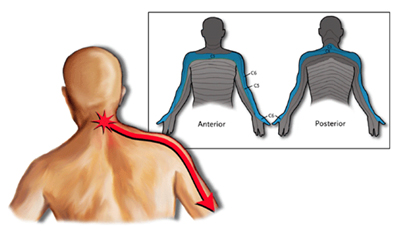Radiculopathy is the term used to describe the symptoms of nerve root irritation, which can include pain, numbness, tingling and weakness.
What Is Radiculopathy?
Nerve roots are the paired bundles of nerve fibers that extend from the spinal cord through openings on the side of each vertebra. The nerves that extend from each area of the spinal cord are connected to specific parts of the body. Those in the cervical spine, for example, extend to the upper chest and arms; those in the lumbar spine the hips, buttocks and legs. The nerves also carry electrical signals back to the brain, creating sensations.
Radiculopathy is often caused by direct pressure from a herniated disc or degenerative changes in the spine that cause irritation and inflammation of the nerve roots. Radiculopathy usually creates a pattern of pain and numbness that is felt in your arms or your legs in the area of the skin that’s supplied the by the sensory fibers of the nerve root, and weakness in the muscles that are also supplied by the same nerve root.

What Are The Symptoms Of Radiculopathy?
The most common symptom of lumbar radiculopathy is sciatica, or pain that radiates from the back into the buttocks and legs. Sensory symptoms are more common than motor symptoms, and muscle weakness is usually a sign that the nerve compression is more severe. The quality and type of pain can vary, from dull, aching, and difficult to localize, to sharp, burning, and easy to pinpoint.
Cervical radiculopathy typically manifests as pain, numbness and weakness that extend from the neck into the shoulders, arms and/or hands. Other symptoms can include neck pain and headaches near the back of the head (occiput); arm reflexes also may be impaired.
Radiculopathy can create hypersensitivity to touch as well as numbness in the area of skin that’s served by the affected nerve root. If you are experiencing any of these symptoms, particularly muscle weakness, please see your provider. The longer the source of nerve irritation remains untreated, the greater the potential for long-term or permanent nerve damage.
How Is Radiculopathy Diagnosed?
The correct diagnosis of the cause of your symptoms begins with a complete physical examination. Your provider will examine your back for flexibility, range of motion, and the presence of certain signs that suggest a particular nerve root is being affected. This often involves testing the strength of your muscles and checking your reflexes to make sure that they are still working normally.

Your provider also may use a diagnostic tool such as magnetic resonance imaging (MRI) or a computed tomography (CT or CAT) scan. An MRI scan is very useful for determining where the nerve roots are being compressed because this type of a scan is designed to show the details of soft-tissue structures, such as nerves and discs. A CT scan is often used to evaluate the bony anatomy in the lumbar spine, which can show how much space is available for the nerve roots. The nerve roots exit the spinal canal through a bony tunnel called the neuroforamen, and it is at this point that the nerve roots are especially vulnerable to compression.
How Is Radiculopathy Treated?
Your provider will be able to discuss with you what your diagnosis means in terms of treatment options. Non-surgical therapies such as medication, rest or physical therapy are typically recommended first. However, if these therapies fail to provide lasting relief over the reasonable length of time, or if there is evidence that nerve root compression is causing nerve damage, your provider may recommend spine surgery. The goal of surgery is alleviate your symptoms and prevent further damage by removing the source of pressure on the spinal nerve roots.
Spinal surgeons perform a variety of procedures to achieve spinal decompression. When determining the optimal surgical procedure, a surgeon will consider patient pathology (the structural and functional changes that led to the patient’s neurological dysfunction), the level or levels of the spine affected, the patient’s medical history and his or her surgical experience and training.
Today, spinal decompression also can be performed using a minimally invasive technique that allows your spine surgeon to dilate the muscles surrounding your spine rather than stripping the muscles away from the spine.
The benefits of spine surgery, however, must be weighed against the risks. Your surgeon will be able to discuss the risks and benefits of surgery with you, and the likely results of operative versus non-operative treatment.

